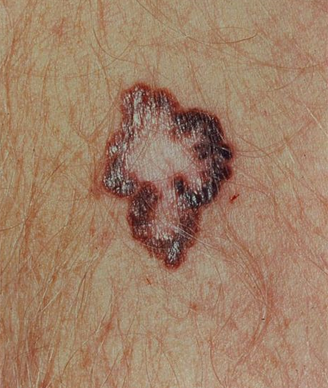PD-1 Inhibitor MK-3475 Again Shows Promise in Advanced Melanoma
The PD-1 inhibitor MK-3475 is continuing to show activity and long-term responses in patients with metastatic melanoma, according to results presented at the International Congress of the Society for Melanoma Research.
Human metastatic melanoma cells; H&E stain, magnified to 320x.

MK-3475, an immunotherapy antibody against programmed death 1 (PD-1)-a key immune-checkpoint receptor expressed on some cancer cells-is continuing to show activity and long-term responses in patients with metastatic melanoma. The highest rate of objective response so far is 51% (51 patients) for those treated at the highest dose (10 mg/kg every 2 weeks), including 14% who experienced a complete response.
The overall response for all 116 patients treated at all 3 doses tested is 41%, including 9% experiencing a complete response. Eighty-eight percent of these responses are ongoing.
Results from the 116–melanoma patient cohort of a large multi-cancer phase I study were presented at the 10th International Congress of the Society for Melanoma Research (SMR), held November 17–20 in Philadelphia. A previous update of data from this patient cohort was presented at the American Society of Clinical Oncology annual meeting this summer. (See Combined Immunotherapies Show Promise in Metastatic Melanoma.)
The median duration of response at a median follow-up duration of 14.5 months has not yet been reached, according to presenter Caroline Robert, MD, head of dermatology at the Institut Gustave Roussy in Paris.
The 1-year survival rate is 81%, “an impressive rate of overall survival for a single-agent therapy,” said Robert.
Patients were treated with 10 mg/kg either every 2 or 3 weeks or with 2 mg/kg every 2 weeks. After a median follow-up of 14.5 months, 88% (43 patients) of the 49 responding patients continue to respond.
Twenty patients were treated at the lowest treatment dose of 2 mg/kg every 2 weeks. The response rate for these patients, who were all ipilimumab-naive, was 40%, with a 10% complete response rate.
The 24-week progression-free survival (PFS) rate was 54%. Those treated at the highest dose schedule had a 24-week PFS of 62%.
Durable responses to MK-3475 were seen both in ipilimumab-naive patients and in patients previously treated with ipilimumab. Seventy-five percent of the patients had a wild-type version of the BRAF gene and 22% had BRAF-mutated tumors. Fourteen percent of the patients had received three or more prior therapies.
“Most responses occur early in the treatment regimen, but patients also [had responses that] occurred beyond 6 months of treatment,” said Robert.
Most adverse events experienced by patients have been mild. The most common side effects were fatigue (37%), pruritus (26%), and rash (22%). Higher-grade drug-related adverse events were experienced by 13% of patients. High-grade adverse events were more frequent at the highest dosage schedule: 14 patients (25%) experienced a grade 3 or 4 adverse event. Immune-related grade 1/2 pneumonitis occurred in 7 patients (5%).
Robert noted that it is not clear why there is a difference in the rate of response for the highest dose of MK-3475 but that it will be necessary to understand how to best administer MK-3475, including knowing the optimal duration of treatment.
An ongoing three-arm phase III trial of MK-3475 in metastatic melanoma is comparing two different MK-3475 doses (10 mg/kg either every 2 or 3 weeks) to ipilimumab given at 3 mg/kg every 3 weeks.
MK-3475 has also recently shown activity in a cohort of patients with nonsquamous and squamous non–small-cell lung cancer (NSCLC) from the same phase I trial as the current melanoma patients.
Other anti–PD-1 and anti–PD-L1 agents, such as nivolumab and MPDL3280A, are also currently being tested in phase III trials, including the combination of two immunotherapy antibodies for metastatic melanoma patients.